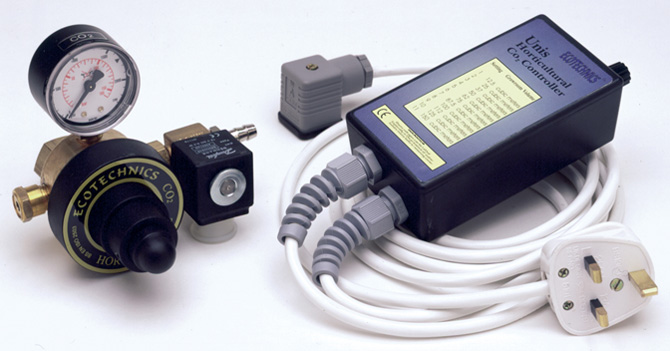
 |
|
Hydroponics - Indoor HorticultureHydroponics - Indoor Horticulture represents an educational, in-depth,
up-to-date, indoor horticultural growers guide that covers all principles
of indoor Hydroponics - Indoor Horticulture examines, explores, dissects and
presents a fully comprehensive step by step growers guide, relating
to all and every aspect of indoor hydroponic horticulture, with complete
chapters on plant biology, propagation, hydroponic systems, nutrients,
oxygen, carbon dioxide enrichment, pH, biological pest control, fungi/disease,
cuttings/clones, pruning/training, breeding, harvesting, equipment,
grow rooms, a full history of hydroponics, and more. |
(Below follows a one page
sample taken from the book)CO2 Bottled Gas Release System |
||
 |
||
The other option for generating controlled carbon dioxide injection is an emitter system, which works from compressed bottles of pure CO2. These systems are almost risk free and produce no toxic gases, no heat and no water. But you guessed it; they are neither cheap to buy nor cheap to run. These units also allow very precise, metered delivery of exact amounts of CO2 directly where you want it. They are available as two types – a manual continuous flow option or an automatic short bursts option. Bottles of CO2 gas can be obtained from all good hydroponics stores, or direct from an industrial manufacturer of these bottles and gas. You normally have to pay a deposit and rental on the bottle, then after this payment you simply pay the refill costs. Typically, the bottle you have purchased is swapped in for a full bottle every time you need it to be refilled. The manual flow system works by way of a solenoid valve controlled with a short range timer that regulates the flow of CO2 into the grow room. The solenoid valve is operated electronically via the timer and is used to start and stop the flow of gas from the regulator. This short range timer opens the solenoid valve for brief periods of times in the light cycle. Normal timers are not suited for this application and their on and off times are generally too long, injecting far more CO2 than the plants require. The manual methods mean you have to work out the flow rate and the injection duration of CO2 to obtain optimum conditions. You have to work this out with a complicated formula. Divide the number of cubic feet required by the flow rate. The cubic feet measurement is obtained by measuring the length, width and breadth of the grow room and times them together. For example, if the flow rate is set at 10 cubic feet per hour then the valve will need to open for 0.1 hours which is 1 divided by 10, or in English – 6 minutes, as this equates to 0.1 hour x 60 minutes. This will bring the room up to 1500 PPM. As CO2 is heavier than air it is likely to leak out from the grow room. On average, the CO2 levels will deplete to 300 parts per million in approximately 3 hours due to leakage and plant’s usage. |
The other option of an automated CO2 release system works by having an already calculated injection rate by means of a controller that is linked to a regulator via a solenoid valve. With this system, you simply work out the square volume of the area you want to inject, dial this measurement into the controller and this gadget does the rest, preset at a level of 12000 parts per million. The very latest one even comes with a built-in light cell so that the CO2 regulator even switches itself off during the night cycle. These systems, although obviously more costly, simply take the grief out of CO2 injection. They do all the calculations for you and once set, will inject CO2 almost every other minute in very short and measured bursts directly to your high energy plants. The way the CO2 is delivered to the plants is typically done via a small perforated delivery tube. You would suspend the tube, making sure it is looped in a ring from your CO2 regulator, to ensure even delivery through the whole pipe system above your plants. This tubing carries CO2 from the supply tank to the centre of your grow room above your plants. It has to be above your plants because, as mentioned previously, CO2 is heavier and cooler than air, so it actually acts more like water than a gas. As soon as it is released, it falls on top of the plants. This method of releasing compressed CO2 gas is virtually risk free and very precise, however, is expensive to buy and expensive to run, so larger growers tend to steer clear of it. However, when you compare the increase in yield, CO2 is quickly becoming a must for a supercharged garden. |
|
|
 |